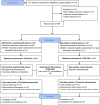Involuntary reflexive pelvic floor muscle training in addition to standard training versus standard training alone for women with stress urinary incontinence: a randomized controlled trial
- PMID: 33566173
- PMCID: PMC8885550
- DOI: 10.1007/s00192-021-04701-5
Involuntary reflexive pelvic floor muscle training in addition to standard training versus standard training alone for women with stress urinary incontinence: a randomized controlled trial
Abstract
Introduction and hypothesis: Although involuntary reflexive pelvic floor muscle contractions seem crucial during stress urinary incontinence-provoking situations, hitherto existing guidelines feature voluntary pelvic floor muscle training only. Two pelvic floor muscle protocols were compared regarding their effect on stress urinary incontinence in women: one focusing on standard physiotherapy with voluntary pelvic floor muscle training, the other additionally including involuntary reflexive pelvic floor muscle training.
Methods: This study was designed as a triple-blind prospective randomized controlled trial with women suffering from stress urinary incontinence with two physiotherapy intervention groups (control group: standard physiotherapy, n = 48, experimental group: standard physiotherapy plus involuntary reflexive pelvic floor muscle training triggered by whole-body movements such as jumps n = 48). Both interventions lasted 16 weeks (9 personal physiotherapy consultations and 78 home training sessions). Group differences and development over time were analyzed concerning the primary outcome International Consultation on Incontinence Modular Questionnaire Urinary Incontinence short form (ICIQ-UIsf) by mixed effect regression models.
Results: The ICIQ-UIsf score decreased significantly over time for both groups by about 3 points from about 10 to about 7 points with no group differences at any point in time.
Discussion: This trial did not find any additional benefit for stress urinary incontinence by adding involuntary reflexive pelvic floor muscle training to standard training. Both training protocols showed similar clinically relevant improvements; however, there was still moderate incontinence after interventions. Future studies should test and apply pelvic floor muscle function-oriented training methods for pelvic floor muscle hypertrophy, intramuscular coordination, and power, which are more in line with conventional skeletal muscle training, i.e., performed with higher intensities and workout.
Keywords: Exercise; Muscle contraction; Physical therapy modalities; Reflex.
© 2021. The Author(s).
Conflict of interest statement
None.
Figures


References
Publication types
MeSH terms
Grants and funding
LinkOut - more resources
Full Text Sources
Other Literature Sources
Medical

